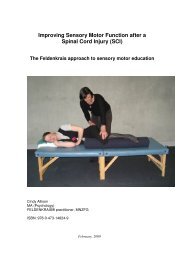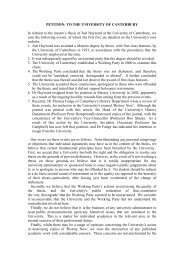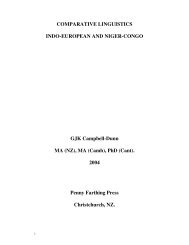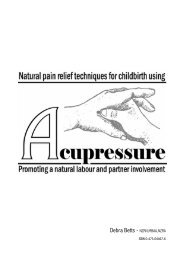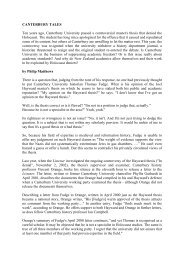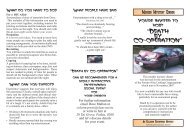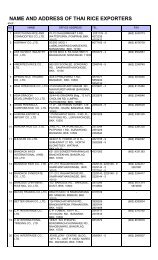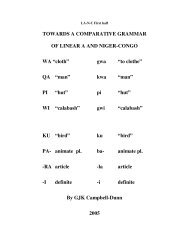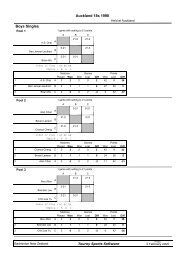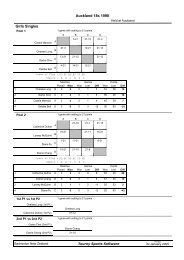Wairua and the relationship it has with learning te reo ... - Clear Net
Wairua and the relationship it has with learning te reo ... - Clear Net
Wairua and the relationship it has with learning te reo ... - Clear Net
You also want an ePaper? Increase the reach of your titles
YUMPU automatically turns print PDFs into web optimized ePapers that Google loves.
L<strong>it</strong>erature Review, Perception:<br />
Ethno-linguist Whorf, championed by Indigenous scholars was able<br />
to describe <strong>the</strong> connection between one’s language <strong>and</strong> world view from<br />
an analysis of grammar pat<strong>te</strong>rning. “Language embodies <strong>the</strong> way society<br />
thinks” (L<strong>it</strong>tle Bear 2000:78)(Whorf 1956:87,88) <strong>and</strong> provides us w<strong>it</strong>h a key<br />
to gaining some insight into o<strong>the</strong>r ways of knowing. Many Indigenous<br />
languages “provide distinct perspectives on <strong>and</strong> underst<strong>and</strong>ings of <strong>the</strong><br />
world, which educational research <strong>has</strong> ignored” (Battis<strong>te</strong> 2000:199). As<br />
linguist, Moonhawk Alford <strong>has</strong> argued <strong>it</strong> is time to revis<strong>it</strong> <strong>the</strong> Whorf<br />
hypo<strong>the</strong>sis <strong>and</strong> explore <strong>the</strong> usage pat<strong>te</strong>rns of gender, verbs, nouns <strong>and</strong><br />
concepts of living/non-living <strong>and</strong> time <strong>and</strong> <strong>the</strong>ir subsequent effect upon<br />
ones thinking (Moonhawk Alford 2005). The use of time <strong>and</strong> verbs in Māori<br />
help to illustra<strong>te</strong> this point.<br />
The past in Māori thinking is in front of us, <strong>the</strong> word for past is mua <strong>and</strong><br />
this is also <strong>the</strong> word for ‘in front’. The word for future is muri which is also<br />
<strong>the</strong> word for back <strong>and</strong> behind. This concept of time, very different to<br />
European time <strong>has</strong> us pulling <strong>the</strong> past into our future by l<strong>it</strong>erally walking<br />
“backwards into <strong>the</strong> future” (Hohepa 2005).<br />
Verbs take <strong>the</strong> root form, once you have <strong>the</strong> subject in a sen<strong>te</strong>nce you<br />
don’t need to repeat <strong>it</strong>, <strong>the</strong> focus is on <strong>the</strong> verb as this is <strong>the</strong> Māori<br />
pat<strong>te</strong>rning, whereas European languages are noun focussed. Algonquian<br />
languages are similarly “verb orien<strong>te</strong>d” (Youngblood Henderson<br />
2000:262). Ra<strong>the</strong>r than ca<strong>te</strong>gorising, specifying or naming, which is <strong>the</strong><br />
function of a noun, a language that is verb focussed is fluid, moving <strong>and</strong><br />
oscillating. Verbs become <strong>the</strong> main vehicle for thought. The effect this<br />
difference <strong>has</strong>, as explained by Blackfoot speaker Amethyst First Rider, is<br />
a kines<strong>the</strong>tic experience; a thought is felt ra<strong>the</strong>r than visualised. ”When<br />
she says even <strong>the</strong> simplest things in English, such as ‘The man is riding a<br />
horse,’ pictures come up in her head: but when she says <strong>the</strong> equivalent in<br />
Blackfoot, <strong>the</strong>re aren’t pictures, just feelings of riding” (Moonhawk Alford<br />
2002:25).<br />
The Māori language <strong>has</strong> similar<strong>it</strong>ies to Blackfoot; <strong>it</strong> does not radically<br />
distinguish between “thought <strong>and</strong> feeling” (Salmond 1985:246), thus<br />
21



